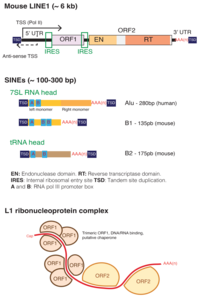
Photo from wikipedia
LINE-1 (L1) retrotransposons are mobile genetic elements capable of "copy-and-pasting" their own sequences into random genomic loci and one of the proteins it uses to achieve mobility is LINE-1 open… Click to show full abstract
LINE-1 (L1) retrotransposons are mobile genetic elements capable of "copy-and-pasting" their own sequences into random genomic loci and one of the proteins it uses to achieve mobility is LINE-1 open reading frame 1 protein (L1ORF1p). L1ORF1p expression is found across many epithelial cancers, including small cohorts of ovarian and endometrial cancers, and is highly expressed in cancers with mutant p53 expressions. Here we aimed to gain insights into L1ORF1p expression levels within specific histotypes of ovarian cancers: high grade serous (n=585), low grade serous (n=26), clear cell (n=132), endometrioid (n=148), and mucinous (n=32) ovarian cancers, as well as endometrial cancers (n=607) using tissue microarray (TMA's). We demonstrated that L1ORF1p expression is associated with advanced stage and serous histotype in gynecological cancers. Like previous studies, we found a higher proportion of L1ORF1p expression in cases with aberrant p53 expression. We evaluated the expression of L1ORF1p in serous tubal intraepithelial carcinomas (STICs) (n=6) and p53 signature lesions (n=2) in fallopian tubes. Three STIC cases displayed aberrant p53 overexpression with corresponding L1ORF1p expression in the same tissues, but such correlation was not seen in the two p53 signature lesions, suggesting that L1 protein may be expressed after dysplastic transformation. The remaining three STIC cases have TP53 nonsense mutations with absent p53 expression but a strong and clear L1ORF1p expression within the STIC lesions. While L1ORF1p may not be prognostic in gynecological cancers, it may be useful clinically as a diagnostic IHC marker for p53 null STIC lesions and this warrants further investigation.
Journal Title: Human pathology
Year Published: 2019
Link to full text (if available)
Share on Social Media: Sign Up to like & get
recommendations!